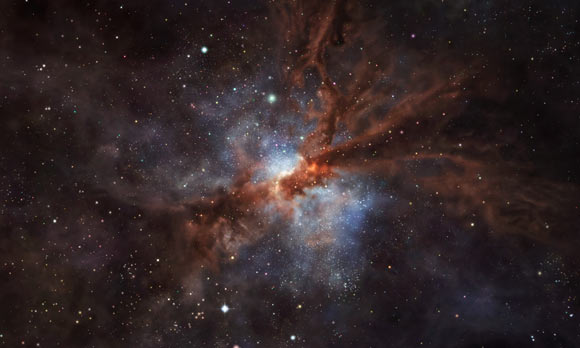Fluorine is one of the most interesting elements for nuclear and stellar astrophysics. Fluorine abundance was first measured for stars other than the Sun in 1992, then for a handful of metal-poor stars, which are likely to have formed in the early Universe. Now, astronomers using the Atacama Large Millimeter/submillimeter Array (ALMA) have detected fluorine — in the form of hydrogen fluoride — in the gravitationally lensed starburst galaxy NGP-190387.

This artist’s impression shows NGP-190387, a dusty star-forming galaxy that is so far away its light has taken over 12 billion years to reach us. Image credit: ESO / M. Kornmesser.
“We all know about fluorine because the toothpaste we use every day contains it in the form of fluoride,” said Dr. Maximilien Franco, an astronomer at the University of Hertfordshire.
“Like most elements around us, fluorine is created inside stars but, until now, we did not know exactly how this element was produced.”
“We did not even know which type of stars produced the majority of fluorine in the Universe!”
Dr. Franco and colleagues detected fluorine in large gas clouds of NGP-190387, which we see as it was when the Universe was only 1.4 billion years old.
Since stars expel the elements they form in their cores as they reach the end of their lives, this detection implies that the stars that created fluorine must have lived and died quickly.
“We believe that Wolf-Rayet stars, very massive stars that live only a few million years, a blink of the eye in the Universe’s history, are the most likely production sites of fluorine,” the astronomers said.
“They are needed to explain the amounts of hydrogen fluoride we spotted.”
Wolf-Rayet stars had been suggested as possible sources of cosmic fluorine before, but astronomers did not know until now how important they were in producing this element in the early Universe.
“We have shown that Wolf-Rayet stars, which are among the most massive stars known and can explode violently as they reach the end of their lives, help us, in a way, to maintain good dental health,” Dr. Franco said.
Besides these stars, other scenarios for how fluorine is produced and expelled have been put forward in the past.
An example includes pulsations of giant, evolved stars with masses up to few times that of our Sun, called asymptotic giant branch stars.
But the authors believe these scenarios, some of which take billions of years to occur, might not fully explain the amount of fluorine in NGP-190387.
“For this galaxy, it took just tens or hundreds of millions of years to have fluorine levels comparable to those found in stars in the Milky Way, which is 13.5 billion years old. This was a totally unexpected result,” said Professor Chiaki Kobayashi, also from the University of Hertfordshire.
“Our measurement adds a completely new constraint on the origin of fluorine, which has been studied for two decades.”
The discovery is described in a paper in the journal Nature Astronomy.
_____
M. Franco et al. The ramp-up of interstellar medium enrichment at z > 4. Nat Astron, published online November 4, 2021; doi: 10.1038/s41550-021-01515-9







